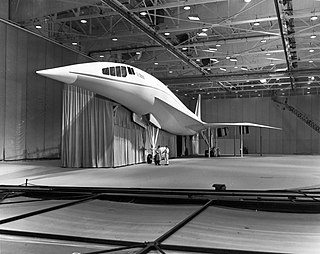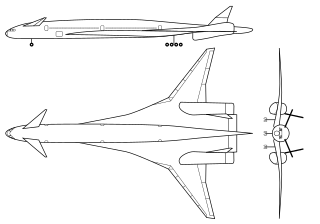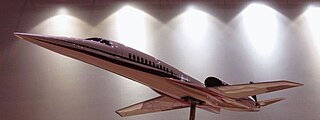Related Research Articles

Concorde is a retired Franco-British supersonic airliner jointly developed and manufactured by Sud Aviation and the British Aircraft Corporation (BAC). Studies started in 1954, and France and the UK signed a treaty establishing the development project on 29 November 1962, as the programme cost was estimated at £70 million . Construction of the six prototypes began in February 1965, and the first flight took off from Toulouse on 2 March 1969. The market was predicted for 350 aircraft, and the manufacturers received up to 100 option orders from many major airlines. On 9 October 1975, it received its French Certificate of Airworthiness, and from the UK CAA on 5 December.

The Tupolev Tu-144 is a Soviet supersonic passenger airliner designed by Tupolev in operation from 1968 to 1999.

The Boeing 2707 was an American supersonic passenger airliner project during the 1960s. After winning a competition for a government-funded contract to build an American supersonic airliner, Boeing began development at its facilities in Seattle, Washington. The design emerged as a large aircraft with seating for 250 to 300 passengers and cruise speeds of approximately Mach 3. It was intended to be much larger and faster than competing supersonic transport (SST) designs such as Concorde.

The North American Aviation XB-70 Valkyrie is a retired prototype version of the planned B-70 nuclear-armed, deep-penetration supersonic strategic bomber for the United States Air Force Strategic Air Command. Designed in the late 1950s by North American Aviation (NAA), the six-engined Valkyrie was capable of cruising for thousands of miles at Mach 3+ while flying at 70,000 feet (21,000 m).

A supersonic transport (SST) or a supersonic airliner is a civilian supersonic aircraft designed to transport passengers at speeds greater than the speed of sound. To date, the only SSTs to see regular service have been Concorde and the Tupolev Tu-144. The last passenger flight of the Tu-144 was in June 1978 and it was last flown in 1999 by NASA. Concorde's last commercial flight was in October 2003, with a November 26, 2003 ferry flight being its last airborne operation. Following the permanent cessation of flying by Concorde, there are no remaining SSTs in commercial service. Several companies have each proposed a supersonic business jet, which may bring supersonic transport back again.

The Lockheed L-2000 was Lockheed Corporation's entry in a government-funded competition to build the United States' first supersonic airliner in the 1960s. The L-2000 lost the contract to the Boeing 2707, but that competing design was ultimately canceled for political, environmental and economic reasons.

The Boeing Sonic Cruiser was a concept jet airliner with a delta wing–canard configuration. It was distinguished from conventional airliners by its delta wing and high-subsonic cruising speed of up to Mach 0.98. Boeing first proposed it in 2001, but airlines generally preferred lower operating costs over higher speed. Boeing ended the Sonic Cruiser project in December 2002 and shifted to the slower, but more fuel-efficient 7E7 airliner.

The Republic XF-103 was an American project to develop a powerful missile-armed interceptor aircraft capable of destroying Soviet bombers while flying at speeds as high as Mach 3. Despite a prolonged development, it never progressed past the mockup stage.

Inlet cones are a component of some supersonic aircraft and missiles. They are primarily used on ramjets, such as the D-21 Tagboard and Lockheed X-7. Some turbojet aircraft including the Su-7, MiG-21, English Electric Lightning, and SR-71 also use an inlet cone.

An airplane, or aeroplane, informally plane, is a fixed-wing aircraft that is propelled forward by thrust from a jet engine, propeller, or rocket engine. Airplanes come in a variety of sizes, shapes, and wing configurations. The broad spectrum of uses for airplanes includes recreation, transportation of goods and people, military, and research. Worldwide, commercial aviation transports more than four billion passengers annually on airliners and transports more than 200 billion tonne-kilometers of cargo annually, which is less than 1% of the world's cargo movement. Most airplanes are flown by a pilot on board the aircraft, but some are designed to be remotely or computer-controlled such as drones.

A supersonic aircraft is an aircraft capable of supersonic flight, that is, flying faster than the speed of sound. Supersonic aircraft were developed in the second half of the twentieth century. Supersonic aircraft have been used for research and military purposes, but only two supersonic aircraft, the Tupolev Tu-144 and the Concorde, ever entered service for civil use as airliners. Fighter jets are the most common example of supersonic aircraft.

A trijet is a jet aircraft powered by three jet engines. In general, passenger airline trijets are considered to be second-generation jet airliners, due to their innovative engine locations, in addition to the advancement of turbofan technology. Trijets are more efficient than quadjets, but not as efficient as twinjets, which replaced trijets as larger and more reliable turbofan engines became available.

A supersonic business jet (SSBJ) is a business jet travelling above the speed of sound: a supersonic aircraft. Some manufacturers are designing or have been designing SSBJs, but none are currently available. Usually intended to transport about ten passengers, proposed SSBJs would be about the same size as subsonic business jets.

The Rockwell XFV-12 was a prototype supersonic United States Navy fighter which was built in 1977. The XFV-12 design attempted to combine the Mach 2 speed and AIM-7 Sparrow armament of the McDonnell Douglas F-4 Phantom II in a VTOL fighter for the small Sea Control Ship which was under study at the time. On paper, it looked superior to the subsonic Hawker Siddeley Harrier attack fighter. However it was unable to demonstrate an untethered vertical takeoff and its inability to meet performance requirements terminated the program.

The Tupolev Tu-244 was a proposed supersonic transport (SST) aircraft, developed from the Tu-144. It implemented novel features such as cryogenic fuel to enable flight distances of up to 10,000 km (6,200 mi) and would have carried up to 300 passengers. The project was cancelled in 1993.

In supersonic aerodynamics, an unstart refers to a generally violent breakdown of the supersonic airflow. The phenomenon occurs when mass flow rate changes significantly within a duct. Avoiding unstarts is a key objective in the design of the engine air intakes of supersonic aircraft that cruise at speeds in excess of Mach 2.2.
The Avion de Transport Supersonique Futur (ATSF) also known as Alliance, was a concept design for supersonic transport that was being worked on by both British Aerospace and Aérospatiale. The aircraft was to be based on the experience learned from the supersonic Concorde, and was to fly at a top speed of roughly Mach 2. Preliminary designs were produced, with some wind-tunnel testing of small-scale models, but development apparently stalled in the early 2000s.

The Rolls-Royce/Snecma Olympus 593 was an Anglo-French turbojet with reheat, which powered the supersonic airliner Concorde. It was initially a joint project between Bristol Siddeley Engines Limited (BSEL) and Snecma, derived from the Bristol Siddeley Olympus 22R engine. Rolls-Royce Limited acquired BSEL in 1966 during development of the engine, making BSEL the Bristol Engine Division of Rolls-Royce.

This article briefly describes the components and systems found in jet engines.

The North American NAC-60 was the first American supersonic transport (SST) project. The development took place in the 1960s as part of a government-funded design competition to build an American SST as the joint Anglo-French Concorde and the short-serviced Soviet Tupolev Tu-144 were underway. The design, however, due to being slower and smaller than the expectations of the American SST Race, was rejected in favor of the Lockheed and Boeing designs, allowing them to get further study.
References
- Notes
- Bibliography
- (After), "After the DC-8", Flight International, 30 November 1961, p. 849
- Erik Conway, "High-speed dreams: NASA and the technopolitics of supersonic transportation", JHU Press, 2005